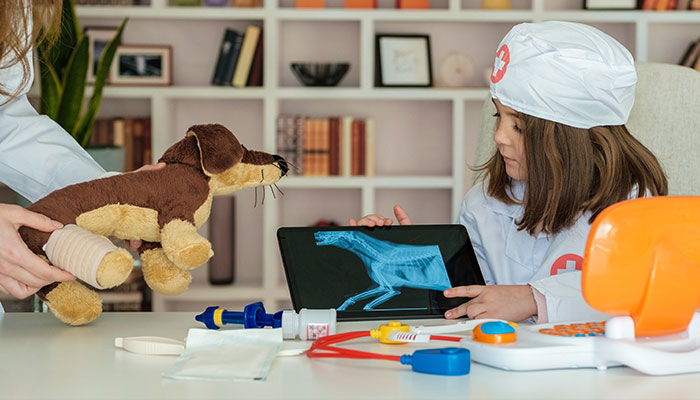While we believe that the books and resources recommended may be of value to you, keep in mind that these are suggestions only and you must do your own due diligence to determine whether the materials are appropriate and suitable for your use. PNC has no sponsorship or endorsement agreement with the authors or publishers of the materials listed.
COMMUNITY HELPERS

Veterinarian
Children will learn about veterinarians as community helpers.

Lesson Objective
Children will learn about veterinarians as community helpers and the tools they use; children will also make animal x-ray art.
ScienceArt
What You'll Need
Note: You will need to search the Internet for images of “Aboriginal art of a lizard” and animal x-rays.
- Images of Aboriginal art – from an Internet search
- Animal x-rays – from an Internet search
- Stethoscope
- Empty medicine bottles
- Bandages
- Colored glue – 2 bottles
- Small, shallow cups – 1 per 2 children
- Paper – 1 sheet per child
- Cotton swabs – 4 per child
- Bingo markers – 1 per child
What To Do
- Tell the children they will be learning about a community helper who is a special kind of doctor called a veterinarian.
- Explain that a veterinarian takes care of animals in much the same way as a doctor takes care of people (see Did You Know?).
- Display the stethoscope, medicine bottles, and bandages, and ask whether the children recognize these tools and their use (see Guiding Student Inquiry).
- Display an animal x-ray, and explain how a veterinarian might use an x-ray.
- Display the artwork, and ask children what they see.
- Point out the bones and organs in the artwork, and explain that this type of artwork resembles an x-ray (see Did You Know?).
- Tell the children they will be making x-ray artwork.
- Distribute paper and bingo markers.
- Have the children use the bingo markers to draw an animal of their choice on the paper.
- Distribute cotton swabs and cups of colored glue.
- Have children dip both ends of a cotton swab in the glue and place it on their animal’s body to create bones. Allow children to place 5–10 swabs on their artwork.
Resources
Home School Resources
Home educators: use these printable lesson PDFs to teach this lesson to your home schoolers. They're available in English and Spanish.
Content Provided By
Common Core State Standards Initiative – These lessons are aligned with the Common Core State Standards ("CCSS"). The CCSS provide a consistent, clear understanding of the concepts and skills children are expected to learn and guide teachers to provide their students with opportunities to gain these important skills and foundational knowledge [1]. Visit the CCSS



